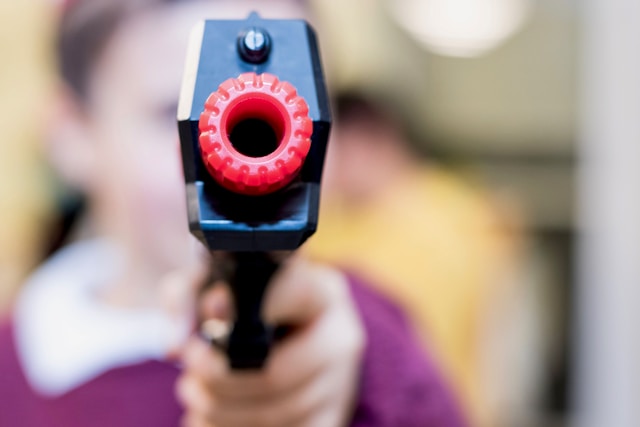
Child Shooting
The earliest known instance of a child shooting someone dead with just their hands was a case of a girl who cocked her fingers and said, pyoo-pyoo at her brother who was teasing her. Toddlers can make guns out of anything, banana gun, cheese sandwich with a bite taken out of it-gun, spoon gun. One afternoon, while a mother fed her son with a turkey pterodactyl that had been flying so happily into his mouth, he made it into a gun, and went pyoo-pyoo at his mom. Normally, the mother would pretend to be hit, Oh, you got me! and they would laugh and go on with their day. This time, a bullet materialized from the turkey and hit his mother square in the forehead. She slumped down. When the father came home, he found the toddler hysterical with tears and snot streaming down his face. All over, toddlers were making things into guns: straw gun, toilet paper roll gun. Their caregivers were afraid and started to bind their hands. One parent would grab one hand, and one the other (so the child could not make a gun). They would wrap their hands round and round until they couldn’t move their fingers. Of course, the children couldn’t tie their shoes anymore, but Velcro shoes were fine just as long as the parents were protected. The parents who had wrapped their children’s hands saw them raising their arms and saying, woo-woo, crash! Flames shot out from their arms and explosions cracked the night sky. California fires started. This had gotten out of hand. The military got wind of this: if children could make bullets from their imagination, why have a bullet forge? They began recruiting the children, taping their fingers like a gun. They had polycarbonate bullet-resistant plastic placed between them so they couldn’t shoot each other. At their naptime, they were so exhausted that they didn’t think about making guns or explosions. They shot into an assembly line and bullets were packaged and sent off for the war in Ukraine. Their caregivers were relieved. They even made a big deal of it, like a quinceañera, or a kindergarten graduation. From age two until seven, when most children’s egocentrism goes away and they are actually able to think about consequences of their actions, they are packed off to the factory. They are useful engines.